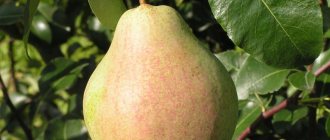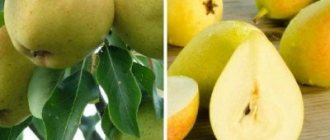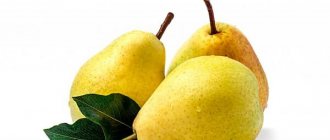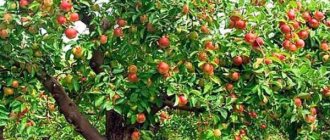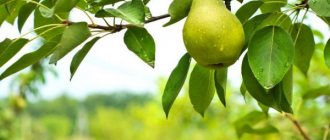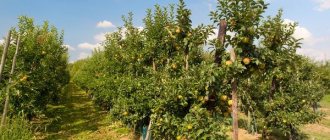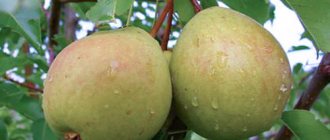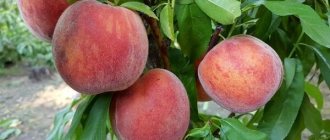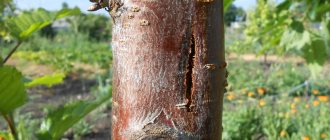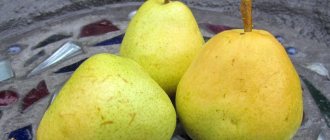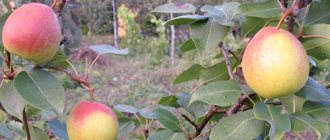Types of Bergamot pears.
Fruiting
Early fruitfulness is individual for each particular variety. On average, the first fruits appear after 5-7 years. Yield rates are very high. The tree bears fruit annually. After 20 years of continuous fruiting, the pear may need rejuvenating pruning.
Bergamot pear.
Forms and subspecies
The Bergamot group includes the following pear varieties:
- Novik. The variety has good winter hardiness. The fruits are yellow and weigh about 90-100 grams. Tastes sweet and juicy. They ripen in early September and are stored for about 10 days.
- Nutmeg. The tree is resistant to frost and scab. Pears are light green with a slight red blush. The fruits have a sweet, dessert taste, with a pleasant honey aroma. They ripen in the third decade of July and are stored for about a week.
- Autumn. The fruits are yellow-green and weigh on average 120 grams. The taste is good, sweet. The pulp is juicy. The fruits are removed from the tree in early September and stored for about 7 days.
- Volzhsky. Pears are dark green, with a slight blush on the sunny side. The taste is tender, sweet and very juicy. They ripen in the first half of September and retain their quality for about a month.
- Dagestan. The variety has high frost resistance. The fruits can weigh about 150 grams. The main color of pears is light green, without blush. The taste is sweet, juicy, with sourness. The harvest is removed from the tree in early autumn and left to ripen for 2-3 weeks. After reaching consumer maturity, pears can be stored for several months.
- Rossoshansky. The pear is resistant to scab and frost. Productivity is at an average level. The fruits weigh about 80 grams and are stored for up to 30 days. Pears reach ripeness in early autumn.
- Moscow. Large-fruited variety. The pears are bright green, without blush, and weigh about 180 grams. The taste is good, sweet and sour. The fruits ripen in September and can be stored in the refrigerator for up to two months.
- In memory of Prince Trubetskoy. Pear is unpretentious to external conditions and resistant to frost. The fruits are large, yellow-green, with a pleasant sweet and sour taste. If the right conditions are provided, the crop can be stored until the end of winter.
Bergamot variety.
Main characteristics of bergamot pear
According to one version, the name of the bergamot pear comes from the name of the Italian city of Bergamo, where this variety was bred. Fruits of this type were very popular in the territory of the former USSR - then a certain variety was grown in each region. Today these fruit trees can be found in Europe, Russia and China.
Characteristics of wood
The bergamot pear is a fruit tree that produces a harvest of ripe fruits in early autumn. This crop belongs to the rose family and is self-fertile, so it does not have to be planted near pollinating crops.
Main characteristics of the variety:
- The height of the tree depends on the variety and can range from 7 to 15 m.
- The crown is dense, has a pyramidal or oval shape and consists of oblong ovoid leaves. Their surface is smooth and their color is bright green.
- The flowering period falls in May. The flowers are collected in inflorescences and have white or white-pink petals.
- Life expectancy is more than 20 years. The highest fruit yield occurs in the first few years.
- Trees of this species have good frost resistance, but in severe frosts they can freeze.
- The average yield of the crop is about 80 kg of fruit from each tree, but under suitable growing conditions this figure can increase to 140 kg. Increased yields are facilitated by rejuvenating pruning of branches and planting next to other varieties of pears.
- Trees have good immunity to all diseases except scab. The crop is also afraid of freezing and rodents, so it needs additional protection.
Description of fruits
The first harvest of ripe fruits from a bergamot pear can only be harvested after it reaches the age of 8 years.
Fruiting repeats annually, and ripe fruits have the following characteristics:
- The shape of the fruit is flat-round, medium size. On the outside, they are covered with a smooth and thin skin that is light green or yellow in color with a slight reddish blush.
- The pulp has a granular structure and green-white color. It has a rich, sweet taste and is very juicy. Overripe fruit acquires a peculiar tart taste.
- Pears have a rich chemical composition; their pulp contains trace elements, carbohydrates, essential oils and monosaccharides. The calorie content of the fruit is 50 kcal per 100 g.
- The average weight of one fruit is about 200 g. Ripe fruits can be stored for 2 months.
- Bergamot pear is eaten fresh and is also used in folk medicine to treat diseases of the digestive system. Tree bark is used industrially as a natural dye for fabrics.
Important! After ripening, the fruits of the bergamot pear do not fall to the ground, but remain hanging on the branches of the tree.
Reviews
Rossoshansky Bergamot grows in my garden. The tree is unpretentious and hardy. The yield is not bad, but I would like it to be better. Of course, pears taste great. Can be stored in the refrigerator for up to two months.
Gregory
Michurinsk
My parents have been growing a Bergamot pear in their garden for over 20 years. No one knows exactly what kind of variety it is, but according to friends it looks like Muscat. Pears are very beautiful, tasty and aromatic. They ripen early. Usually we start picking them from the tree in mid-July.
Ruslan
Velikie Luki
Bergamot is one of the most favorite types of pear. They ripen early and smell very good. Their pleasant taste allows them to be added to baked goods and jam. I also like to dry it so that I can make compote and baked goods later.
Marianne
Moscow region
Preparing pears for wintering
Preparatory work usually begins with cleaning the area around the tree. Fallen leaves and carrion from branches are collected, and dried fruits are removed. Old mulch is also removed. It is advisable to burn all this garbage.
Dried and diseased branches are removed from the tree. The entire crown and trunk are sprayed from scab. You can use a 5% urea solution for this. Growths are also removed from the trunk.
To protect the Bergamot trunk from rodents (hares, mice), the tree is wrapped with protective material. For these purposes, ordinary burlap and spruce wood are suitable.
Landing
Planting technology and preparation of the planting hole can significantly affect the strengthening and growth of the tree in the future. This issue should be approached very responsibly. Useful recommendations for planting Bergamot seedlings can be found in the selection of articles below.
How to plant a pear tree correctly
At what distance to plant pears?
How to choose pear seedlings
How to replant a pear
Description and characteristics of the variety
The Bergamot variety is an autumn variety, which explains its demand among agronomists. There are a small number of autumn varieties. The seedlings grow rapidly and adapt to private gardens and nurseries. Breeders position this variety as vigorous. The crown is characterized by a pyramidal shape and is dense. The branches are long and thin, the leaves have an unusual boat shape. The height of the tree reaches 6 meters. The duration of fruiting and life of a fruit tree is average.
The tree begins to bear fruit late, 7-9 years after planting. Optimal conditions for development and fruiting are a mild climate, the absence of severe winter frosts and winds. Cold resistance indicators are relative.
Pear Bergamot
Important! The critical temperature is −20 degrees, in which case the tree dies. The time to harvest is usually at the beginning of September.
From each mature tree, subject to agrotechnical rules, it is possible to harvest up to 150 kg of pears
The time to harvest is usually at the beginning of September. From each mature tree, subject to agrotechnical rules, it is possible to harvest up to 150 kg of pears.
The fruits are small in size, round in shape, slightly flattened on the sides. The pulp has a rich characteristic aroma; it is white in color with a yellow tint. The harvest must be harvested as it ripens. When overripe, the structure of the fruit becomes mealy, and the taste deteriorates. This crop is famous for its high content of nutrients in its fruits. They are recommended to enrich the diet for diseases of the genitourinary system, pancreas and liver. The advantage of the fruits is that they can be transported over long distances.
Varieties of pear
Pear bergamot Moscow; description: trees of this variety have a compact crown, the amount of foliage is average. The leaves have an elongated oval shape, the medium-sized fruits have a flattened-round shape, and are green in color. The pulp is medium density, coarse-grained and juicy. If pears are stored for a long time, the taste increases in sourness and astringent properties. The plant bears its first fruits after 4 years; from one trunk, subject to the rules of agricultural technology, it is possible to collect up to 20 kg of pears.
Autumn Bergamot is a popular variety among gardeners. Mature trees reach medium height, the crown is characterized by a pyramidal shape, the branches are short and slightly pubescent. The leaves are pointed and elongated. The shelf life of ripe fruits is about three weeks, their weight is approximately 80 g, the pulp is loose. A significant advantage is the high level of cold resistance. The crop begins to bear fruit after 7-8 years. Pears have a round shape, green-yellowish color, with small dots. On the sunny side, a tan forms as it ripens. The pulp has a sweet wine taste and a loose consistency.
Nutmeg bergamot has distinctive features: the diameter of the crown of an adult tree can reach 12 meters, and the height is also impressive. This variety bears fruit very abundantly; about 250 kg of pears are harvested from one tree. It is worth noting that the variety bears fruit well even at 60 years of age. The time to harvest is approaching in August; the fruits are colored yellowish and have an oblong shape. The taste is excellent, the flesh is creamy in color.
Please note: all varieties of Bergamot pear are of particular interest to wasps, and their fruits ripen quickly
Care
Bergamot varieties are generally unpretentious, but for the full development of the pear and maintaining the health of the plant, watering, fertilizing and other necessary procedures should be carried out in a timely and regular manner. More materials on this issue can be found by following the links below.
How to care for a pear Pruning a pear Pruning a columnar pear Treating a pear from diseases and pests Feeding a pear How to water a pear
Bergamot Moscow
The most popular among domestic gardeners is the Moscow Bergamot variety, which has a compact crown and medium tree height. Zoned for the Moscow region and found in Moscow.
This is an autumn variety that bears fruit well, allowing you to get the first fruits already in the 4th year. The Bergamot Moscow pear variety has ribbed fruits that are quite large, which is not typical for this variety. Their weight can reach 150 grams.
The color of ripe fruit is yellow with a brown blush. The pulp is dense and juicy, with a characteristic sweet taste. Harvesting of Bergamot Moscow begins in September.
From a small tree you can get about 20 kilograms of fruit. Unfortunately, shelf life is not very high, so it is recommended to store the harvested crop for no more than two weeks. We also note the possible deterioration in the taste characteristics of pears with insufficient moisture.
This variety, like most varieties of Bergamot, is self-fertile. However, to increase productivity, pollinators such as Naryadnaya Efimova, Kosmicheskoye and Mramornoe should still be planted in close proximity.
Diseases and pests
Some varieties are resistant to various diseases, but in order to completely eliminate the risk of infection, it is necessary to regularly carry out preventive measures. Detailed instructions and tips for protecting wood can be found in the articles below.
Dangerous Pear Pests
Pears often suffer from pests, they affect the leaves, bark and fruits.
In this article, we have selected 11 of the most harmful insects that harm pear trees, and also ways to destroy them.
Diseases of pear trees
To get what they cherish, gardeners have to work hard, and the reason for this is pear diseases.
Read about 19 common pear diseases and how to combat them.
How to trim a pear (video)
The fruits are medium in size, short pear-shaped, with wide ribbing and a smooth surface, greenish-yellow in color, with good keeping quality. The pulp is white or light yellow in color, with sufficient juiciness, semi-oily type, sour-sweet, very pleasant, refreshing taste. Varietal advantages are represented by early fruiting, high productivity, winter hardiness, decent resistance to scab, keeping quality and taste of the fruit. The downside of the variety is its poor compatibility with quince rootstock, which should be taken into account when growing pear plantations in home gardening conditions in our country.
Thai bergamot - medicinal properties and contraindications
Before we look at the benefits and uses of bergamot oil, I want to make one disclaimer. Every time I bring up the topic of essential oils, I remind you that there are natural and synthesized essential oils. Natural - plant origin. Synthesized - no.
A liter of Thai bergamot essential oil from a wholesale supplier costs approximately $300-350. If you pour it into 10 ml bottles, then without taking into account all the costs of packaging, transportation and related expenses, the cost of 10 ml of pure natural oil will be 3-3.5 dollars. This is without manufacturer, wholesaler and retail surcharges. Compare this with the price at the nearest pharmacy, and you will see how synthesized oil differs from natural oil.
The essential oil is obtained from the peel of the fruit and leaves of the kaffir lime. There is more oil in the peel, but it is more aromatic in the leaves. At the last exhibition, I found a manufacturer of natural essential oils in Thailand, and now you can buy natural Thai bergamot essential oil in our store at a reasonable price.
Pappeda leaves are used in cooking - in the preparation of sauces, curries, and tom yam soup. The juice of the fruit can be used together with lemon juice, or instead of it. Kaffir lime leaves and juice are used to neutralize the odor of fish in cooking.
And the kaffir lime tree is considered favorable for growing near the home - it brings happiness))
What are the benefits of Thai bergamot, that is, kaffir lime:
Thai bergamot has antioxidant properties, strengthens the immune system, and resistance to disease
- Helps improve appetite
- Kaffir lime essential oil helps relieve stress, anxiety, and calm the mind. For aromatherapy, it is recommended to mix pure essential oil with water in a ratio of 1:100
- Helps get rid of insomnia
- Has a tonic effect on the heart
- Helps relieve fever, dizziness
- Helps relieve cough and improve expectoration
- Cleanses the blood. Fresh pappeda fruits are mixed with honey or salt, poured with clean water and infused. If you drink this infusion for a month, it cleanses the blood well.
- Kaffir lime leaves have properties that help inhibit or slow down the growth of cancer cells. They are rich in beta-carotene, and bergamot may help fight cancer
- Bergamot juice can be used to treat scurvy. After brushing your teeth, use kaffir lime juice and rub it on your gums.
- Fresh papped peel helps solve intestinal problems - colic, flatulence, bloating
- Helps with abdominal pain, used as a natural analgesic for children
- Helps with poisoning, abscess (inflammation) of internal organs. Inhibits the growth of microorganisms
- Reduces pain from spasms
- Prevents premature graying. Solves the problem of hair loss. Makes them shiny and makes combing easier. If you have access to fresh fruits, you can use their juice to make hair rinsing solutions. In Thai hair products, bergamot is an important and popular ingredient - see the list below
- Helps cleanse hair of chemicals. No matter how good hair cosmetics are, they usually contain chemical components. Apply fresh bergamot juice to your hair, leave for 10 minutes and rinse with clean water - the hair will become shiny, and the remaining chemicals will be washed away along with the water
- Used to treat dandruff
- The strong smell of bergamot repels insects - mosquitoes, moths, ants. This property is even used in the industrial sector to control pests on farms. When bitten by ticks or leeches, pappeda juice is dripped onto the bite site, and the pest will come out on its own
- Helps solve the problem of stinky feet, unpleasant odors in closets with clothes and shoes. Kaffir lime leaves are placed in a fabric bag with other ingredients (ginger, galangal, citronella, etc.) - this helps to completely remove unpleasant odors.
As you can see, the range of properties of Thai bergamot is much wider than one might expect when wondering about the benefits and harms of tea with bergamot. Are there any contraindications? I found one thing: when using pure oil for external use, you should not go out into direct sunlight for 4 hours - there is a risk of getting skin burns.
And now, knowing the benefits of Thai bergamot and where it grows, I present a list of products containing its extract and oil. I’ll say right away that there are many more such products - just enter the word “bergamot” into the search window and you will see two pages of product options and a page with articles where it is mentioned.
Bio Herbal anti-hair loss shampoo - in a large bottle of 500 ml and in a standard bottle of 200 ml
Bio Herbal anti-hair loss tonic - in a large bottle of 100 ml and a small bottle of 30 ml
Hair lotion with bergamot essential oil - in a large bottle of 100 ml and a small bottle of 30 ml
Organic shampoo “Bergamot”
Organic hair conditioner “Bergamot”
Organic hair mask “Bergamot”
All of these products use the beneficial properties of bergamot for hair. There are other cosmetic products that use its anti-stress properties.
Organic shower gel “Bergamot”
Aromatic balm with kaffir lime essential oil
Massage oil with bergamot essential oil
Yes, most of the benefits of pappeda are available to those who can buy or collect fresh fruits or leaves. But cosmetics manufacturers make it possible to use the beneficial properties of kaffir lime in hair and body care products. Let them bring you benefit and pleasure!
Features of cultivation
In order for the Bergamot pear variety to become part of your garden collection, you need to approach its growing conditions with the utmost care. First of all, select a well-ventilated area for the seedling. The optimal types of soil are chernozem or loam. During the process of growing pears, you will need to feed the soil with organic compounds (manure and urea) from time to time.
Another important condition for cultivating Bergamot varieties is an abundance of sunlight. However, there is one nuance here: during periods of extreme heat, it is recommended to shade young seedlings so that they do not get burned. Such a pear also needs regular and abundant watering. Their frequency should be increased during the period of fruit ripening.
Bergamot Autumn
Autumn Bergamot pear is a folk selection that is widespread in the middle part of the country. Medium-sized trees bear fruit well, allowing you to get small-sized fruits with excellent taste. The yellow skin has pronounced rusty spots.
Harvesting maturity of this variety occurs in September, with shelf life of no more than a month. Fruiting begins no earlier than 8 years after planting. Gardeners also need to consider susceptibility to scab and fungal diseases, so be sure to treat trees accordingly.
Read also: Strawberry and Victoria: what is the difference and what is the difference, description
